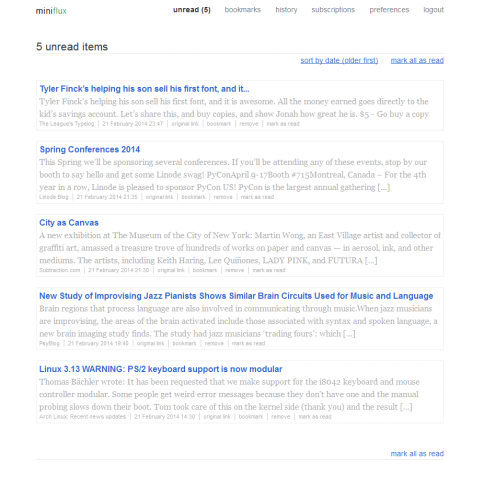Miniflux
Miniflux is a minimalist and open source feed reader. It has no bloat, no social media, no folders. It even has no search.
For some, this lack of features can be a deal breaker. For others—like me—it’s just what the doctor ordered.
After the shutdown of Google Reader, I had migrated my feeds to CommaFeed. CommaFeed is also a minimalist and open source feed reader, though not as bare bones as Miniflux. And while I was quite happy with CommaFeed, I was not self-hosting it; instead, I was using its hosted service. I did create an account on Red Hat’s OpenShift, which is a fine venue for hosting CommaFeed, but I already had a VPS at Linode (which is awesome, by the way), and I wanted a feed reader that I could easily run on my existing Linode. Tiny Tiny RSS came with enthusiastic recommendations, but for some reason I never really warmed up to it. Then one day when I was idly browsing through GitHub, I came across Miniflux.

Miniflux provides a simple, readable interface that looks and works perfect on small and large screens alike. One of its few features is the ability to download full content of articles, which is handy for those feeds that include only a summary. There are no folders, and surprisingly, I don’t miss them. I was also surprised at how easy the installation was: all it required was a simple git clone and some necessary web server configuration, and voila, it was up and running. (For those who cannot or do not want to self-host, there’s a hosted version available for a small, one-time fee.) And finally, being small and bloat-free means that Miniflux is fast—really fast.
Of course, Miniflux is not for everybody, but if you are a fan of minimalism and web feeds, you should check it out.